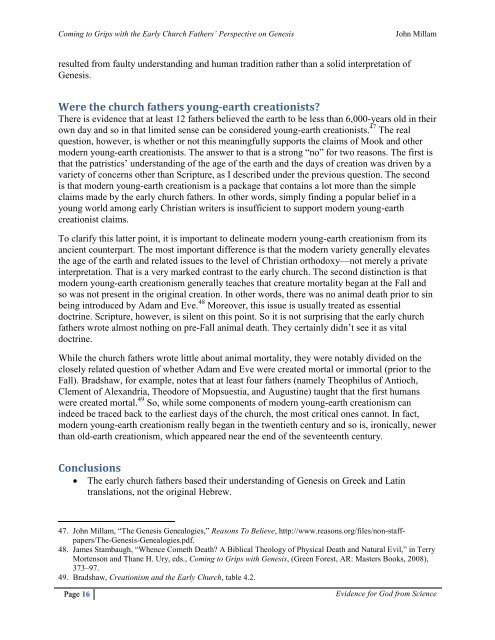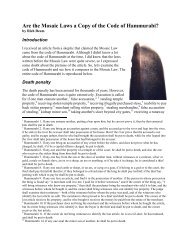Coming to Grips with the Early Church Fathers - Evidence for God ...
Coming to Grips with the Early Church Fathers - Evidence for God ...
Coming to Grips with the Early Church Fathers - Evidence for God ...
You also want an ePaper? Increase the reach of your titles
YUMPU automatically turns print PDFs into web optimized ePapers that Google loves.
<strong>Coming</strong> <strong>to</strong> <strong>Grips</strong> <strong>with</strong> <strong>the</strong> <strong>Early</strong> <strong>Church</strong> Fa<strong>the</strong>rs’ Perspective on Genesis John Millam<br />
resulted from faulty understanding and human tradition ra<strong>the</strong>r than a solid interpretation of<br />
Genesis.<br />
Were <strong>the</strong> church fa<strong>the</strong>rs young-earth creationists?<br />
There is evidence that at least 12 fa<strong>the</strong>rs believed <strong>the</strong> earth <strong>to</strong> be less than 6,000-years old in <strong>the</strong>ir<br />
own day and so in that limited sense can be considered young-earth creationists. 47 The real<br />
question, however, is whe<strong>the</strong>r or not this meaningfully supports <strong>the</strong> claims of Mook and o<strong>the</strong>r<br />
modern young-earth creationists. The answer <strong>to</strong> that is a strong “no” <strong>for</strong> two reasons. The first is<br />
that <strong>the</strong> patristics’ understanding of <strong>the</strong> age of <strong>the</strong> earth and <strong>the</strong> days of creation was driven by a<br />
variety of concerns o<strong>the</strong>r than Scripture, as I described under <strong>the</strong> previous question. The second<br />
is that modern young-earth creationism is a package that contains a lot more than <strong>the</strong> simple<br />
claims made by <strong>the</strong> early church fa<strong>the</strong>rs. In o<strong>the</strong>r words, simply finding a popular belief in a<br />
young world among early Christian writers is insufficient <strong>to</strong> support modern young-earth<br />
creationist claims.<br />
To clarify this latter point, it is important <strong>to</strong> delineate modern young-earth creationism from its<br />
ancient counterpart. The most important difference is that <strong>the</strong> modern variety generally elevates<br />
<strong>the</strong> age of <strong>the</strong> earth and related issues <strong>to</strong> <strong>the</strong> level of Christian orthodoxy—not merely a private<br />
interpretation. That is a very marked contrast <strong>to</strong> <strong>the</strong> early church. The second distinction is that<br />
modern young-earth creationism generally teaches that creature mortality began at <strong>the</strong> Fall and<br />
so was not present in <strong>the</strong> original creation. In o<strong>the</strong>r words, <strong>the</strong>re was no animal death prior <strong>to</strong> sin<br />
being introduced by Adam and Eve. 48 Moreover, this issue is usually treated as essential<br />
doctrine. Scripture, however, is silent on this point. So it is not surprising that <strong>the</strong> early church<br />
fa<strong>the</strong>rs wrote almost nothing on pre-Fall animal death. They certainly didn’t see it as vital<br />
doctrine.<br />
While <strong>the</strong> church fa<strong>the</strong>rs wrote little about animal mortality, <strong>the</strong>y were notably divided on <strong>the</strong><br />
closely related question of whe<strong>the</strong>r Adam and Eve were created mortal or immortal (prior <strong>to</strong> <strong>the</strong><br />
Fall). Bradshaw, <strong>for</strong> example, notes that at least four fa<strong>the</strong>rs (namely Theophilus of Antioch,<br />
Clement of Alexandria, Theodore of Mopsuestia, and Augustine) taught that <strong>the</strong> first humans<br />
were created mortal. 49 So, while some components of modern young-earth creationism can<br />
indeed be traced back <strong>to</strong> <strong>the</strong> earliest days of <strong>the</strong> church, <strong>the</strong> most critical ones cannot. In fact,<br />
modern young-earth creationism really began in <strong>the</strong> twentieth century and so is, ironically, newer<br />
than old-earth creationism, which appeared near <strong>the</strong> end of <strong>the</strong> seventeenth century.<br />
Conclusions<br />
The early church fa<strong>the</strong>rs based <strong>the</strong>ir understanding of Genesis on Greek and Latin<br />
translations, not <strong>the</strong> original Hebrew.<br />
47. John Millam, “The Genesis Genealogies,” Reasons To Believe, http://www.reasons.org/files/non-staffpapers/The-Genesis-Genealogies.pdf.<br />
48. James Stambaugh, “Whence Cometh Death? A Biblical Theology of Physical Death and Natural Evil,” in Terry<br />
Mortenson and Thane H. Ury, eds., <strong>Coming</strong> <strong>to</strong> <strong>Grips</strong> <strong>with</strong> Genesis, (Green Forest, AR: Masters Books, 2008),<br />
373–97.<br />
49. Bradshaw, Creationism and <strong>the</strong> <strong>Early</strong> <strong>Church</strong>, table 4.2.<br />
Page 16 <strong>Evidence</strong> <strong>for</strong> <strong>God</strong> from Science






